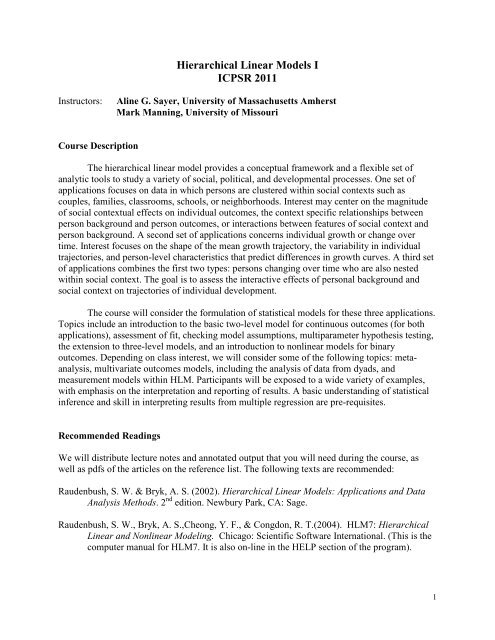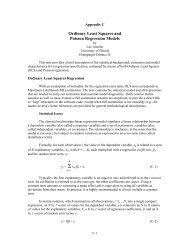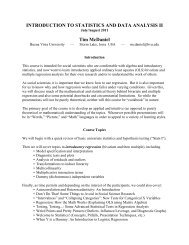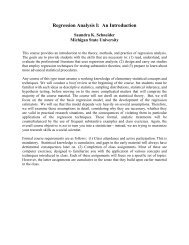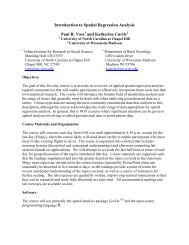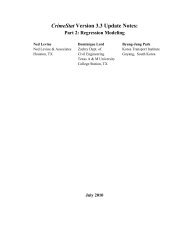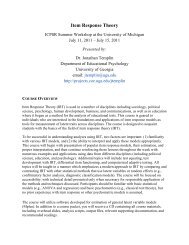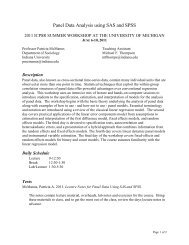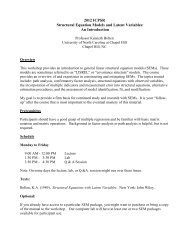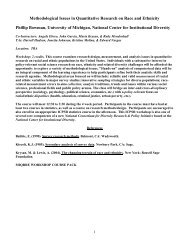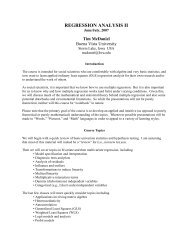Introduction to Hierarchical Linear Models - icpsr
Introduction to Hierarchical Linear Models - icpsr
Introduction to Hierarchical Linear Models - icpsr
Create successful ePaper yourself
Turn your PDF publications into a flip-book with our unique Google optimized e-Paper software.
<strong>Hierarchical</strong> <strong>Linear</strong> <strong>Models</strong> I<br />
ICPSR 2011<br />
Instruc<strong>to</strong>rs:<br />
Aline G. Sayer, University of Massachusetts Amherst<br />
Mark Manning, University of Missouri<br />
Course Description<br />
The hierarchical linear model provides a conceptual framework and a flexible set of<br />
analytic <strong>to</strong>ols <strong>to</strong> study a variety of social, political, and developmental processes. One set of<br />
applications focuses on data in which persons are clustered within social contexts such as<br />
couples, families, classrooms, schools, or neighborhoods. Interest may center on the magnitude<br />
of social contextual effects on individual outcomes, the context specific relationships between<br />
person background and person outcomes, or interactions between features of social context and<br />
person background. A second set of applications concerns individual growth or change over<br />
time. Interest focuses on the shape of the mean growth trajec<strong>to</strong>ry, the variability in individual<br />
trajec<strong>to</strong>ries, and person-level characteristics that predict differences in growth curves. A third set<br />
of applications combines the first two types: persons changing over time who are also nested<br />
within social context. The goal is <strong>to</strong> assess the interactive effects of personal background and<br />
social context on trajec<strong>to</strong>ries of individual development.<br />
The course will consider the formulation of statistical models for these three applications.<br />
Topics include an introduction <strong>to</strong> the basic two-level model for continuous outcomes (for both<br />
applications), assessment of fit, checking model assumptions, multiparameter hypothesis testing,<br />
the extension <strong>to</strong> three-level models, and an introduction <strong>to</strong> nonlinear models for binary<br />
outcomes. Depending on class interest, we will consider some of the following <strong>to</strong>pics: metaanalysis,<br />
multivariate outcomes models, including the analysis of data from dyads, and<br />
measurement models within HLM. Participants will be exposed <strong>to</strong> a wide variety of examples,<br />
with emphasis on the interpretation and reporting of results. A basic understanding of statistical<br />
inference and skill in interpreting results from multiple regression are pre-requisites.<br />
Recommended Readings<br />
We will distribute lecture notes and annotated output that you will need during the course, as<br />
well as pdfs of the articles on the reference list. The following texts are recommended:<br />
Raudenbush, S. W. & Bryk, A. S. (2002). <strong>Hierarchical</strong> <strong>Linear</strong> <strong>Models</strong>: Applications and Data<br />
Analysis Methods. 2 nd edition. Newbury Park, CA: Sage.<br />
Raudenbush, S. W., Bryk, A. S.,Cheong, Y. F., & Congdon, R. T.(2004). HLM7: <strong>Hierarchical</strong><br />
<strong>Linear</strong> and Nonlinear Modeling. Chicago: Scientific Software International. (This is the<br />
computer manual for HLM7. It is also on-line in the HELP section of the program).<br />
1
Sequence of Topics<br />
Monday June 13<br />
I. An <strong>Introduction</strong> and Brief His<strong>to</strong>ry<br />
* Methodological criticism of past treatment of hierarchical data<br />
-problems in the measurement of organizational effects<br />
-problems in the measurement of change<br />
* Breakthroughs in statistical theory and computation<br />
II.<br />
The logic of the 2-level hierarchical linear model illustrated by an application <strong>to</strong> the study<br />
of individual change over time: Chapman data<br />
* Modeling change over time for one individual: The Level 1 model<br />
* Modeling change over time for J individuals: The Level 2 model<br />
II<br />
An <strong>Introduction</strong> <strong>to</strong> the HLM 6 Computer Program<br />
* Data input and creating the MDM file<br />
* Interactive execution<br />
* Graphing<br />
IV.<br />
Applications <strong>to</strong> repeated measures: NYS data<br />
* Polynomial models<br />
* Studying correlates of growth<br />
Reading: Raudenbush, & Bryk: Chapters 1,2,6<br />
Tuesday June 14<br />
I. Time-varying covariates and group-mean centering<br />
II.<br />
Assessing Model Fit<br />
* Model comparison tests using deviance statistics<br />
* Proportional reduction of variance<br />
* Multiparameter parameter hypothesis testing<br />
III.<br />
Assessing distributional assumptions via residual analysis<br />
* Level-1 assumptions: Creating and using the level-1 residual file<br />
* Level-2 assumptions: Creating and using the level-2 residual file<br />
2
Reading: Raudenbush, & Bryk: Chapters 3, 9<br />
Wednesday June 15<br />
I. An application of the 2-level model <strong>to</strong> organizational research<br />
II<br />
Simplifications of the General Two-Level Model<br />
* The oneway ANOVA with random effects<br />
* Group means as outcomes<br />
* The contextual effects model<br />
* The oneway ANCOVA with random effects<br />
* Random coefficients regression<br />
* Cross-level model with intercepts and slopes as outcomes<br />
Reading: Raudenbush & Bryk, Chapters 4,5<br />
Thursday June 16<br />
II<br />
<strong>Introduction</strong> <strong>to</strong> the Three-Level Model: Chicago Schools Data & Sustaining Effects<br />
Study<br />
* The level-1 model<br />
* The level-2 model<br />
* The Level-3 model<br />
III<br />
Selected <strong>to</strong>pics (we will choose one)<br />
* The cross-sectional multivariate outcomes model: Barnett data<br />
* Meta-analysis: Teacher expectancy effects<br />
*Measurement models within HLM<br />
Reading: Raudenbush & Bryk, Chapters 7, 8, 9<br />
Friday June 17<br />
I. <strong>Introduction</strong> <strong>to</strong> Non-<strong>Linear</strong> <strong>Models</strong> for Binary and Count Data<br />
* Binary outcomes: Thailand data<br />
Reading: Raudenbush & Bryk, Chapters 10, 11<br />
3
Selected References Organized by Topic<br />
Methodological Overview<br />
Collins, L. M. & Sayer, A. G. (2000). Modeling growth and change processes: Design,<br />
measurement, and analysis for research in social psychology. In Harry Reis and Charles Judd<br />
(Eds.), Handbook of research methods in social psychology.(pp.478-495). Cambridge:<br />
Cambridge University Press.<br />
Raudenbush, S.W. (2000). <strong>Hierarchical</strong> <strong>Models</strong>. In Kotz, S. (Ed.) Encyclopedia of<br />
Statistical Sciences (Volume 3). New York: John Wiley and Sons.<br />
Three-Level and Cross-Classified <strong>Models</strong><br />
Raudenbush, S.W. (1995). <strong>Hierarchical</strong> linear models <strong>to</strong> study the effects of social<br />
context on development. In Gottman, J.M. (Ed.) The Analysis of Change. Mahwah, NJ:<br />
Lawrence Erlbaum, Chapter 6, 165-201.<br />
Raudenbush, S.W. (1993). A crossed random effects model for unbalanced data with<br />
applications in cross-sectional and longitudinal research. Journal of Educational Statistics, 18,<br />
4, 321-349.<br />
School Effectiveness Applications<br />
Lee, V., Loeb, S., & Lubeck, S. (1998). Contextual effects of prekindergarten classrooms<br />
for disadvantaged children on cognitive development: The case of Chapter 1. Child<br />
Development, 69(2), 479-494.<br />
Neighborhood Effects Applications<br />
Garner, CL and Raudenbush,SW (1991). Neighborhood effects on educational<br />
attainment: A multilevel analysis. Sociology of Education, 64, 251-262.<br />
Raudenbush, S.W., & Sampson, R. (1999). Ecometrics: Toward a science of assessing<br />
ecological settings, with application <strong>to</strong> the systematic social observations of neighborhoods.<br />
Sociological Methodology, 29, 1-41.<br />
Sampson, R.J., Raudenbush, S.W., & Earls, F. (1997). Neighborhoods and violent<br />
crime: A multilevel study of collective efficacy. Science, 277, 918-924.<br />
Individual Growth Modeling Applications<br />
Hauser-Cram, P., Warfield, M. E., Shonkoff, J., Krauss, M. W., Upshur, C., & Sayer, A.<br />
(1999). Family influences on adaptive development in young children with down syndrome.<br />
Child Development, 70(4), 979-989.<br />
4
Hauser-Cram, P., Warfield, M., Shonkoff, J., Krauss, M., Sayer, A., & Upshur, C.<br />
(2001). Children with disabilities: A longitudinal study of child development and parent wellbeing.<br />
Monographs of the Society for Research in Child Development, 66 (3, Serial No. 266).<br />
Huttenlocher, J., Haight, W., Bryk, A., Seltzer, M., & Lyons, T. (1991). Early vocabulary<br />
growth: Relation <strong>to</strong> language input and gender. Developmental Psychology, 27, 236-248.<br />
Kee<strong>to</strong>n, C. P., Perry-Jenkins, M., & Sayer, A. G. (2008). Sense of control predicts<br />
depressive and anxious symp<strong>to</strong>ms across the transition <strong>to</strong> parenthood. Journal of Family<br />
Psychology, 22(2), 212-221.<br />
Powers, S. I., Pietromonaco, P., Gunlicks, M., & Sayer, A. (2006). Dating couples’<br />
attachment styles and patterns of cortisol reactivity and recovery in response <strong>to</strong> a relationship<br />
conflict. Journal of Personality and Social Psychology, 90 (4), 613-628.<br />
Svartberg, M., Seltzer, M., Stiles, T., & Khoo, S. T. (1995). Symp<strong>to</strong>m improvement and<br />
its temporal course in short-term dynamic psychotherapy: A growth curve analysis. Journal of<br />
Nervous and Mental Disease, 183 (4), 242-248.<br />
<strong>Hierarchical</strong> <strong>Models</strong> for Dyads<br />
Barnett, R. C., Marshall, N. L., Raudenbush, S. W., Brennan, R. T. (1993). Gender and<br />
the relationship between job experiences and psychological distress: A study of dual-earner<br />
couples. Journal of Personality and Social Psychology, 64 (5), 794- 806.<br />
Goldberg, A. E. & Sayer, A. G. (2006). Lesbian couples’ relationship quality across the<br />
transition <strong>to</strong> parenthood. Journal of Marriage and Family, 68, 87-100.<br />
Lyons, K. S., Zarit, S. H., Sayer, A. G., & Whitlach, C. J. (2002). Caregiving as a dyadic<br />
process: Perspectives from the caregiver and receiver. Journal of Geron<strong>to</strong>logy, 57 (3), 195-204.<br />
Lyons, K. & Sayer, A. G. (2005). Longitudinal dyad models in family research. Journal<br />
of Marriage and Family, 67, 1048-1060.<br />
Raudenbush, S.W., Brennan, R.T., & Barnett, R.C. (1995). A multivariate hierarchical<br />
model for studying psychological change within married couples. Journal of Family Psychology,<br />
9(2), 161-174.<br />
Sayer, A. G. & Klute, M.M. (2005). Analyzing couples and families: Multilevel methods.<br />
In V. L. Bengs<strong>to</strong>n, A. C. Acock, K. R. Allen, P. Dilworth-Anderson, & D. M. Klein (Eds).<br />
Sourcebook of family theory and research (pp. 289-313). Thousand Oaks, CA: Sage.<br />
Accelerated Longitudinal Designs<br />
Raudenbush, S.W. and Chan,W.S. (1993). Application of a hierarchical linear model <strong>to</strong><br />
5
the study of adolescent deviance in an overlapping cohort design. Journal of Consulting and<br />
Clinical Psychology, 61, 941-951.<br />
Jacobs, J. E., Lanza, S., Osgood, D.W., Eccles, J.S., & Wigfield, A.W. (2002) Changes in<br />
Children's Self-Competence and Values: Gender and Domain Differences across Grades One<br />
through Twelve. Child Development, 73, 509-527.<br />
Meta-Analysis<br />
Kalaian, H., & Raudenbush, S.W. (1996). A multivariate mixed model for meta-analysis.<br />
Psychological Methods, 1(3), 227-235.<br />
Raudenbush, S.W. & Bryk, A.S. (1985). Empirical Bayes meta-analysis. Journal of<br />
Educational Statistics, 10(2), 75-98.<br />
Program Evaluation<br />
Seltzer, M. (1994). Studying variation in program success: A multilevel modeling<br />
approach. Evaluation Review, 18, 342-361.<br />
Measurement <strong>Models</strong><br />
Cheong, Y. F. & Raudenbush, S. W. (2000). Measurement and structural models for<br />
children’s problem behaviors. Psychological Methods, 5 (4), 477- 495.<br />
Raudenbush, S.W., Johnson, C., & Sampson, R.J. (2003). A multivariate, multilevel<br />
Rasch model for self-reported criminal behavior. Sociological Methodology,33(1), 169-211.<br />
Binary Outcomes<br />
Horney, J., Osgood, D.W. & Marshall, I.K. (1995). Criminal careers in the short term:<br />
Intra-individual variability in crime and its relation <strong>to</strong> local life circumstances. American<br />
Sociological Review, 60, 655-673.<br />
Rumberger, R.W. (1995). Dropping out of middle school: A multilevel analysis of students<br />
and schools. American Educational Research Journal, 32(3), 583-562.<br />
Multiple Informant/Multiple Outcomes Applications<br />
Brennan, R., Kim, J., Wenz-Gross, M. & Siperstein, G. (2001). The relative equitability<br />
of high-stakes testing versus teacher-assigned grades: An analysis of the Massachusetts<br />
Comprehensive Assessment System (MCAS). Harvard Educational Review, 71 (2), 173-216.<br />
Kuo, M., Mohler, B., Raudenbush, S., & Earls, F. (2000). Assessing exposure <strong>to</strong> violence<br />
using multiple informants: Application of hierarchical linear model. Journal of Child Psychology<br />
and Psychiatry, 41 (8), 1049-1056.<br />
6


